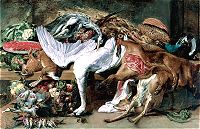 click to enlarge |
STILL LIFE WITH DEAD GAME Frans Snyders and Workshop SN 234, oil on canvas From "The Pages" |
ARTIST:
Frans Snyders was the progenitor of Flemish Baroque still-life and animal painting. He worked intensively for about 50 years, producing an enormous body of work. Through his own painting and his collaboration with Rubens and others, his influence was considerable.
His father, Jan Snyders, ran an inn in Antwerp that was a favorite with artists. In 1593, Frans was apprenticed to Pieter Brueghel III; in 1602 he became a master of the Antwerp Painters’ Guild.
From 1610, after a year in Italy, he was employed by Rubens. In 1611 he married Margaretha de Vos, sister of the painters Cornelis and Paul de Vos.
Around the same time in his career he turned increasingly to hunting scenes. He also produced many kitchen-pieces, which often contained moralistic – or erotic – messages. He continued his collaborations with Rubens, Janssen, Jordaens, Bosschaert, and Boeckhorst.
By 1619, Snyders was a rich man, able in 1622 to buy a house and other properties. It also appears that he ran a large workshop, which probably included Paul de Vos and Jan Fyt, who are known to have worked with Snyders even after he became an independent master himself. In Van Dyck’s portrait of Snyders, he seems to have been a sensitive and distinguished gentleman. The portrait hangs in the Frick Gallery in New York, pendant with that of Snyder’s wife.
SUBJECT:
A profusion of dead game birds and small animals fills the canvas, with the outstanding and decorative addition of a dead swan. Also included are a lobster and various gourds and vegetables. Some tiny birds are skewered and lie on the floor, left of center. A cat lurks beneath, hoping to snatch something from the pile.
PAINTING:
This is a good example of the high quality achieved by workshop productions in the 17th c. It’s an amazing study of textures, color, and line. One feels the soft fur, the brittle plumage, warm flesh, slippery fish. The swan forms a luminous white mass, with the long curving neck leading the eye down. Its curve is echoed by the animal legs, creating the “S” curves which unite the entire composition.
The rhythm is repeated in the color: the muted browns and yellows unify the brilliant white of the swan with the bright reds of the lobster and boar. Modern viewers find the gutted animal repulsive, but the subject was popular in the 17th c. It alludes to both successful hunting and a well-stocked larder.
Exotic animals, dead and alive, were Snyder’s specialty. His masterly handling of a profusion of different objects exemplifies his skill at rhythmical composition; he knew how to combine such objects in well-arranged patterns. The staggering variety of items intended for the rich man’s dinner menu is surely intended to impress us with the wealth of the owner.
John Ringling hung this painting in the breakfast room of his home, Ca d’Zan.